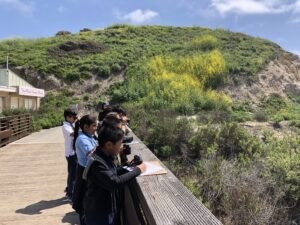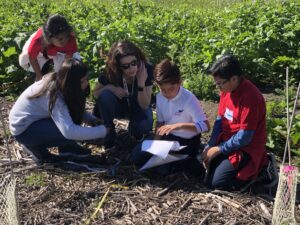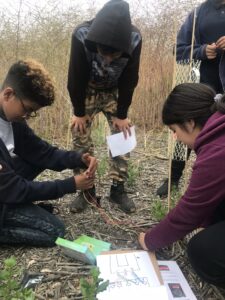Learning About Restoration Ecology
Students and scientists partner to investigate the most effective strategies to use when restoring degraded landscape in Moro Canyon.

Spring in Moro Canyon brings rolling hills that are bursting with yellow flowers. But while they might look striking from afar, the flowers are emblematic of a huge problem that challenges land managers across Southern California: what to do about invading plants like black mustard that can take over a hillside and crowd out the coastal sage scrub plants that provide habitat to a wide range of birds, animals, and insects.
Getting rid of black mustard and restoring a hillside back to natural coastal sage scrub habitat can be extremely challenging. Crystal Cove State Park’s natural resource managers work with very limited staff and resources, and there are plenty of questions about the most effective ways to restore degraded landscapes.
Crystal Cove Conservancy has partnered with State Park natural resource managers, researchers from UC Irvine’s Center for Environmental Biology and School of Education, teachers, and students from across Southern California to help find the answers!
Fifth Graders Study Restoration in Project Crystal
 During Project Crystal, fifth grade students from across Orange County take part in a multi-week investigation to determine the best ways to help coastal sage scrub seedlings grow. It can often be a challenge to ensure that native plants planted in restoration areas survive and thrive long term. Dr. Sarah Kimball at UC Irvine’s Center for Environmental Biology partnered with the State Park to test different methods for increasing the growth and survival of native species.
During Project Crystal, fifth grade students from across Orange County take part in a multi-week investigation to determine the best ways to help coastal sage scrub seedlings grow. It can often be a challenge to ensure that native plants planted in restoration areas survive and thrive long term. Dr. Sarah Kimball at UC Irvine’s Center for Environmental Biology partnered with the State Park to test different methods for increasing the growth and survival of native species.
In the original Project Crystal experiment, which ran from 2016-2018, some of the experimental treatments tested including fencing plants to prevent herbivory, weeding non-natives from the surrounding area, and experimenting with how close seedlings should be planted to established adult shrub. To determine the effectiveness of these strategies, fifth grade students were responsible for measuring the seedling’s growth and water use throughout the spring.
Over 1,000 fifth grade students came to Crystal Cove to help with the project. Their data was included in a scientific journal article which was published in October 2019.
Since 2021, fifth grade students have been assisting with new research studying bird and insect abundance across native plant treatments in Moro Canyon.
Project Crystal represents an innovative approach to outdoor learning that is more than just a field trip. Fifth grade students take part in a curriculum sequence that consists of 20-30 hours of learning, as they ask questions about changing landscapes, build a model of the ecosystem, make a hypothesis, collect data, and then analyze their data and share their findings back with Crystal Cove State Park. Field trips are bracketed by in-class lesson plans, and free training is provided to participating teachers.
Middle School Students Apply Computer Science to Study Restoration
 Building on the success of Project Crystal, in 2019, Crystal Cove Conservancy partnered with two UC Irvine graduate students and Placentia-Yorba Linda Unified School District to launch Project Crystal Code, a middle school version of the our restoration ecology program.
Building on the success of Project Crystal, in 2019, Crystal Cove Conservancy partnered with two UC Irvine graduate students and Placentia-Yorba Linda Unified School District to launch Project Crystal Code, a middle school version of the our restoration ecology program.
During Project Crystal Code, returning middle school students build upon their experiences in fifth grade as they consider the role that microbiomes, decomposition, and the carbon cycle play in restoration. This time, students construct a computer model of the ecosystem that they can use to simulate interactions, and then build and code their own environmental sensors, which they use to collect data when they come out to the state park.
Like the fifth grade program, Project Crystal Code bridges formal and informal learning environments with a suite of in-class curriculum, guiding middle school students to investigate a real-world challenge as they ask questions, make hypotheses, and apply computational concepts such as constructing conditional statements and building algorithms. In doing so, they help scientists develop a better understanding of how different factors affect decomposition rates.
High School Interns Partner with Researchers
 Questions remain about how restoration strategies affect other parts of the coastal sage scrub ecosystem. During the Restoration Ecology high school internship program, volunteer interns work directly with researchers to learn more!
Questions remain about how restoration strategies affect other parts of the coastal sage scrub ecosystem. During the Restoration Ecology high school internship program, volunteer interns work directly with researchers to learn more!
During this year-long program, high school students take part in an ecological restoration experiment from start to finish. As they are mentored by Crystal Cove Conservancy staff, they work with a partner scientist to refine a research question, lay out the experimental design, set up the experiment, collect and analyze data, and make inferences based on their findings. Finally, they present their research to Crystal Cove State Park.
In the inaugural year of the Restoration Ecology internship in 2020, supported by the Foundation for Sustainability and Innovation, high school interns worked with Dr. Wallace Meyer of Pomona College to set up an experiment looking at the impacts of mulch on Moro Canyon’s insect population. Today, the program has shifted towards our Fire Ecology Internship, where students work with Irvine Ranch Conservancy and Crystal Cove State Park to study the impacts of burn scars across Southern California.
Are you a teacher who would like to join us?
For more information or to sign up, please contact the Conservancy by emailing info@crystalcove.org.
